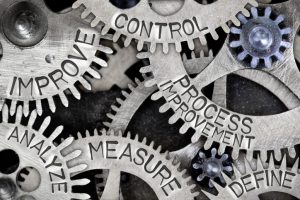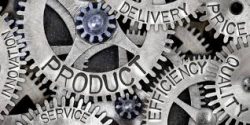40 Manufacturing KPIs That Optimize Production Performance
Controlling and optimizing the production process while keeping maintenance costs in check are essential elements of positive growth. To achieve this growth, successful businesses are relying on key performance metrics and automating many aspects of their data management processes to gain the insights they need to meet their performance goals.
The Basics of Manufacturing KPIs
Manufacturing KPIs or metrics are well-defined measurements to monitor, analyze and optimize production processes regarding quantity, quality and cost. Tracking key performance indicators can support you in delivering consistent quality to your clients, and also ensure that you utilize your resources efficiently.
In an effective KPI strategy, leading indicators that help provide insight into future performance should be balanced with lagging indicators that tell them how they’ve done. I also suggest to our manufacturing clients that they keep the following basic principles in mind relative to their KPI strategies.
- Every KPI needs a clearly defined goal. This goal needs to be something that can be numerically defined (quantitative not qualitative) and attainable in a reasonably finite period of time.
- It is very important that you are able to objectively measure your progress toward the goal by collecting and interpreting data.
- There must be a clearly defined data source with a standardized process for collecting and measuring that data. To accomplish this, our clients rely on the built-in data hub of our Stratum reporting application. The Stratum data hub collects, organizes and stores data from multiple sources and serves as a single version of the truth for helping our clients analyze performance KPIs and metrics across their businesses. Plus, Stratum’s packaged manufacturing analytics (along with analytics that span other areas of their organizations) enable our clients to effectively report on and visualize both their manufacturing-centric and enterprise-focused KPIs.
Download Silvon’s Definitive Guide to KPIs:
Concepts, Best Practices & More
40 Manufacturing KPIs That Drive Results
While there are hundreds of manufacturing KPIs and metrics in use today, I am presenting some of the most effective ones that Silvon has deployed for manufacturers over the past 25+ years. Many of these metrics now come packaged in our Stratum KPI solution or can be easily created in Stratum to support a manufacturing organization’s KPI initiatives.
Machine KPIs
- Capacity Utilization – This measures how much of your available capacity is being used on your production line. It’s important for deciding whether to take on new orders, when quoting lead times, and other activities. The Capacity Utilization KPI also helps to manage what you sell by production center and balance workload by not over- or under-utilizing a particular manufacturing line.
- Changeover Time – Represents the amount of time lost from switching a production line from one product to another or during a shift change. Reducing changeover time unlocks more time for running your production operations and can help you decrease production batch sizes, work-in-process (WIP), and inventory.
- Cycle Time – This is the amount of time it takes from the start of the manufacturing process until the end of the process, which often is the delivery date to the end customer. This includes time spent producing the item and the wait stages between active work times. Cycle Time is also an important part of calculating OEE (Overall Equipment Effectiveness). Getting a grip on cycle time is the first step to accurately measuring how well your production operation is utilized.
- Downtime to Operating Time – Measures the effectiveness of machinery maintenance and the machine itself, taking into consideration both scheduled and unscheduled downtime. Scheduled downtime is planned and includes breaks, lunch, shift changes and meetings. Unscheduled downtime includes events like stock outs, equipment malfunctions, and operator errors.
- Machine Downtime – This KPI is a component of the Overall Equipment Effectiveness (OEE), which is described below. It includes scheduled downtime for maintenance, setups and unscheduled downtime and can include machine changeover.
- Machine Set Up Time – Since a good deal of production time can be lost to set up and changeovers, this measure is ideal for helping you keep track of it. Many of our clients use techniques like attribute sequencing or SMED (single minute exchange of dies or similar techniques) to help them keep such lost time to a minimum.
- Maintenance Cost Per Unit – Typically the maintenance costs per standard unit of production are measured over a specific period, i.e., monthly, quarterly, or annually. This allows a manufacturer to gain insights on trends related to maintenance costs per unit produced and how they are positively or negatively impacting life cycle costs. The maintenance cost metric is flexible and can be applied to one asset, a collection of assets, or a plant as a whole – even multiple plants under an organizational umbrella.
- Overall Equipment Effectiveness (OEE)– OEE is one of the most important performance measurements in modern manufacturing facilities today. This metric measures the overall effectiveness of a piece of production equipment or the entire line; and by optimizing it, you can increase capacity, reduce costs, improve quality and increase your production line efficiencies. An OEE of 100% means that only good parts are produced (100% quality), at the maximum speed (100% performance), and without interruption (100% availability).
- Overall Operations Effectiveness (OOE) – Overall operations effectiveness (OOE) is a maintenance metric used to measure the availability of performance, quality and availability of production lines or other assets from beginning to end. This includes planned maintenance for machines, even though machines are not productive during maintenance times. A company that manages its production well will have an OOE of at least 85%.
- Percentage Planned Maintenance – This KPI metric analyzes the ratio of scheduled maintenance to unscheduled maintenance to identify when more preventative maintenance is required for certain assets.
- Unscheduled Down Time – Unscheduled downtime is painful, especially for asset-intensive organizations. When manufacturers analyze unscheduled downtime data, they glean valuable information such as causes, trends, process issues, bottlenecks and equipment issues. Knowing this information enables manufacturers to improve processes, increase profitability, and calculate overall equipment effectiveness (OEE).
Learn More About Performance KPIs: Get Silvon’s Guide
Inventory KPIs
- Inventory Accuracy – The accuracy of raw materials (or parts) inventory is arguably one of the most important metrics for manufacturing operations. Without adequate levels of accuracy, you cannot effectively plan or forecast from a production standpoint, the supply chain will falter, and the shop floor will suffer from poor productivity and throughput.
- Inventory Turns – In today’s Lean environment, keeping inventories to a minimum can help free up cash and give you the ability to respond to changing customer needs more efficiently and with better delivery times. Tracking Inventory Turns will also help you keep your on-hand inventory fresh and avoid obsolescence.
- Scrap Rate – Keeps track of the number of products that are deemed scrap due to manufacturing or processing defects that can’t be reworked. A high value for this KPI likely indicates poor raw materials, incorrect production setup procedures, faulty machinery or ineffective production operators. A very high Scrap Rate can also lead to an inability to produce enough finished goods to fulfill customer orders.
Quality KPIs
- Quality –There are many ways to measure quality, and “Percent Defective” is one of them. Regardless of the quality metric you decide to use, though, I always encourage my clients to dig into those with low ratings to determine their root causes in order to fix them.
- Failed Audits – Every reliable manufacturer will audit their end product before they send it off to a customer. Failed audits translate into wasted time and resources. Aim for zero with this quality KPI, but optimize your production systems and processes as required should any audit fail.
- First Pass Yield – First Pass Yield (FPY) measures quality units produced as a percentage of the total units that began the process. Our clients track and improve this KPI to reduce waste related to materials, labor, machine depreciation and missed opportunity.
- Rework – This measure is a component of First Pass Yield and involves additional machining or other processes to bring a part “up to code,” if you will. This is a critical KPI due to the time and cost impact that it may have on a production run.
Customer KPIs
- Customer Returns – As a measure of performance, this KPI might indicate a flaw in the production process or a missing step in quality control. Costs related to customer returns can quickly escalate due to reworks.
- On-Time Delivery – While this is a KPI that can keep customer satisfaction at a high level, it can also be motivating to your production employees. Many of the other leading indicators mentioned in this list help drive this one.
Financial / Cost KPIs
- Ending Work-in-Process – This KPI measures the value of partially completed products to help companies understand how much working capital is tied up in incomplete goods. The costs that are included are raw materials or parts used, direct labor and manufacturing overhead.
- Energy Cost Per Unit – Energy Cost Per Unit is a measure of the cost of energy required to produce a specific unit or volume of production.
- Manufacturing Cost as a % of Revenue – This metric is essential in a business’ ability to reduce manufacturing costs, whether it’s through adjustments to materials, labor or overhead.
- Manufacturing Cost Per Unit – This KPI represents the total cost associated with manufacturing a product unit. These are costs that companies generally are able to control and include materials, overhead, depreciation, labor, etc.
Download Silvon’s KPI Guide – Drive Better Business Performance
Employee KPIs
- Absenteeism Rate – The most important reason for this KPI is to understand the effect of absences on productivity, service to your customers, HR costs and employee engagement. Having insight into absence patterns can enable manufacturers to take a more proactive approach to managing fatigue and minimizing absenteeism.
- Employee Turnover – Manufacturing is a tough industry to work in, with tight turnaround times, increasing shipping demands and the need for immaculate quality. The employee turnover KPI measures how many of your production employees leave, voluntarily or not. Low retention levels can ultimately reduce quality and inhibit productivity due to lower employee morale.
- Overtime Hours – This measure compares the amount of overtime worked by employees to the amount of standard hours. I strongly recommend to my clients that they keep their eyes on this one to pinpoint plant floor employees who may be overworked or having to pick up the slack for their coworkers.
- Overtime Rate – Profit per Employee– Even though this KPI is lagging, it takes into consideration how well you are doing on HR-related leading indicators like Training Hours.
- Reportable Health & Safety Incidents – Although this is a lagging indicator, many companies embed it in their culture to help decrease workers’ compensation rates and keep employee morale on the up-and-up. It also serves as a great springboard for implementing effective safety and health programs measured by leading indicators that can drive change.
- Revenue per Employee – This is a basic indicator but can be a quick helpful way to see how your production operations are doing overall. It’s also a good metric to use to compare your company against others in a similar industry.
- Training Hours– This is a great leading indicator that can drive a lot of other KPIs on this list.
Other Manufacturing-Related KPIs

- Avoided Cost – Avoided Costs are expenses that will not be incurred if the associated activity is no longer done. For example, if you discontinue a product line, you will have a variety of avoided costs in the form of labor and equipment usage.
- Cash-to-Cash Cycle Time – Determines the amount of time it takes from an initial cash outlay for raw materials, inventory, and other investments in production until you receive cash from your customers. Aside from its financial implications, cash-to-cash cycles can indicate changes in the health of your supply chain. Lower cycle times can suggest a more profitable, lean business. Additionally, the metric can be a sign of how well you’re using your assets and resources.
- Demand Forecast – A metric used to estimate the amount of raw materials that will be required to meet customer demand. This metric can also be used to predict future customer buying habits in order to optimize inventory levels while meeting customer expectations.
- Material Yield Variance – This KPI compares the estimated amount of material required for a product against the amount of material actually used. If the material yield variance shows that the company is producing less than planned for a given level of input, the visibility provided by the KPI can spur organizations to look into their operations to look for ways to become more efficient.
- Non-Compliance Events / Year – Depending on your industry, you may also want to measure the number of non-compliance events that you have in a year related to safety, emissions, etc. This metric is the number of times in a year that regulatory compliance rules were violated by the plant. In addition to the number of events, it’s often a good idea to measure the length of time the plant was non-compliant, the reasons for non-compliance, and the way the event was resolved.
- Production Attainment – Measures production levels over a specific time period and calculates what percentage of the time a target production level is achieved. This KPI assists with driving performance and improvement to inbound scheduling processes.
- Return on Assets (ROA) – Evaluates how well your business is making use of its assets, including both fixed assets and working capital. An ROA of 5% or more is generally considered good, while 20% or better is considered really good. This all depends on your industry, though. If you’re a heavy-asset manufacturer, for example, your ROA will more than likely be at the lower end of the “good-to-great” scale.
- Takt Time – Determines the maximum permissible amount of time that can be spent making a product while still meeting a client’s deadline. When comparing this to Cycle Time, you can see where potential issues may lie because the deviation is outside of expected parameters. Using this data enables efficient line balancing/rebalancing and a uniform line.
- Throughput – Measures how much a machine, line, or plant can produce over a specified time period. From our decades of experience working with manufacturers in a wide variety of industries, we’ve identified throughput as one of the most important metrics every company should be measuring because it’s the ultimate measure of your line’s performance. Every other KPI on this list (as well as those we’ve left off) is in some way aimed at increasing your throughput.
While not all-inclusive, I hope this list sparks some ideas for the production KPIs you should be measuring. In my next posts, I’ll dive into more detail about each of the KPI categories highlighted above.
Silvon helps mid-market manufacturing companies accelerate growth through our suite of financial and operational planning, reporting and analysis applications. See how we can help you execute your KPI strategy and all of your performance management initiatives from the C-suite to your plant floor.
Download our Free KPI Guide To Stay Focused, Aligned & Accountable






